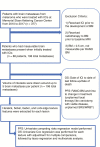MRI radiomic features are associated with survival in melanoma brain metastases treated with immune checkpoint inhibitors
- PMID: 31621883
- PMCID: PMC7145582
- DOI: 10.1093/neuonc/noz141
MRI radiomic features are associated with survival in melanoma brain metastases treated with immune checkpoint inhibitors
Abstract
Background: Melanoma brain metastases historically portend a dismal prognosis, but recent advances in immune checkpoint inhibitors (ICIs) have been associated with durable responses in some patients. There are no validated imaging biomarkers associated with outcomes in patients with melanoma brain metastases receiving ICIs. We hypothesized that radiomic analysis of magnetic resonance images (MRIs) could identify higher-order features associated with survival.
Methods: Between 2010 and 2019, we retrospectively reviewed patients with melanoma brain metastases who received ICI. After volumes of interest were drawn, several texture and edge descriptors, including first-order, Haralick, Gabor, Sobel, and Laplacian of Gaussian (LoG) features were extracted. Progression was determined using Response Assessment in Neuro-Oncology Brain Metastases. Univariate Cox regression was performed for each radiomic feature with adjustment for multiple comparisons followed by Lasso regression and multivariate analysis.
Results: Eighty-eight patients with 196 total brain metastases were identified. Median age was 63.5 years (range, 19-91 y). Ninety percent of patients had Eastern Cooperative Oncology Group performance status of 0 or 1 and 35% had elevated lactate dehydrogenase. Sixty-three patients (72%) received ipilimumab, 11 patients (13%) received programmed cell death protein 1 blockade, and 14 patients (16%) received nivolumab plus ipilimumab. Multiple features were associated with increased overall survival (OS), and LoG edge features best explained the variation in outcome (hazard ratio: 0.68, P = 0.001). In multivariate analysis, a similar trend with LoG was seen, but no longer significant with OS. Findings were confirmed in an independent cohort.
Conclusion: Higher-order MRI radiomic features in patients with melanoma brain metastases receiving ICI were associated with a trend toward improved OS.
Keywords: MRI radiomic features; brain metastases; imaging biomarkers; immune checkpoint inhibitors; intratumoral heterogeneity.
© The Author(s) 2019. Published by Oxford University Press on behalf of the Society for Neuro-Oncology. All rights reserved. For permissions, please e-mail: journals.permissions@oup.com.
Figures


Comment in
-
Imaging biomarkers for brain metastases: more than meets the eye.Neuro Oncol. 2019 Dec 17;21(12):1493-1494. doi: 10.1093/neuonc/noz193. Neuro Oncol. 2019. PMID: 31777936 Free PMC article. No abstract available.
Similar articles
-
Long-term Overall Survival and Predictors in Anti-PD-1-naive Melanoma Patients With Brain Metastases Treated With Immune Checkpoint Inhibitors in the Real-world Setting: A Multicohort Study.J Immunother. 2021 Oct 1;44(8):307-318. doi: 10.1097/CJI.0000000000000385. J Immunother. 2021. PMID: 34406158
-
Concurrent Immune Checkpoint Inhibitors and Stereotactic Radiosurgery for Brain Metastases in Non-Small Cell Lung Cancer, Melanoma, and Renal Cell Carcinoma.Int J Radiat Oncol Biol Phys. 2018 Mar 15;100(4):916-925. doi: 10.1016/j.ijrobp.2017.11.041. Epub 2017 Dec 5. Int J Radiat Oncol Biol Phys. 2018. PMID: 29485071
-
The combination of stereotactic radiosurgery with immune checkpoint inhibition or targeted therapy in melanoma patients with brain metastases: a retrospective study.J Neurooncol. 2020 Jan;146(1):181-193. doi: 10.1007/s11060-019-03363-0. Epub 2019 Dec 14. J Neurooncol. 2020. PMID: 31836957
-
Unmasking of intracranial metastatic melanoma during ipilimumab/nivolumab therapy: case report and literature review.BMC Cancer. 2018 May 9;18(1):549. doi: 10.1186/s12885-018-4470-y. BMC Cancer. 2018. PMID: 29743050 Free PMC article. Review.
-
Checkpoint inhibition and melanoma: Considerations in treating the older adult.J Geriatr Oncol. 2017 Jul;8(4):237-241. doi: 10.1016/j.jgo.2017.04.003. Epub 2017 May 11. J Geriatr Oncol. 2017. PMID: 28506536 Free PMC article. Review.
Cited by
-
Radiomics-guided checkpoint inhibitor immunotherapy for precision medicine in cancer: A review for clinicians.Front Immunol. 2023 Mar 1;14:1088874. doi: 10.3389/fimmu.2023.1088874. eCollection 2023. Front Immunol. 2023. PMID: 36936913 Free PMC article. Review.
-
Radiomics to predict outcomes and abscopal response of patients with cancer treated with immunotherapy combined with radiotherapy using a validated signature of CD8 cells.J Immunother Cancer. 2020 Nov;8(2):e001429. doi: 10.1136/jitc-2020-001429. J Immunother Cancer. 2020. PMID: 33188037 Free PMC article.
-
Incorporating radiomics into clinical trials: expert consensus endorsed by the European Society of Radiology on considerations for data-driven compared to biologically driven quantitative biomarkers.Eur Radiol. 2021 Aug;31(8):6001-6012. doi: 10.1007/s00330-020-07598-8. Epub 2021 Jan 25. Eur Radiol. 2021. PMID: 33492473 Free PMC article.
-
The Role of the Immune Response in Brain Metastases: Novel Imaging Biomarkers for Immunotherapy.Front Oncol. 2021 Oct 26;11:711405. doi: 10.3389/fonc.2021.711405. eCollection 2021. Front Oncol. 2021. PMID: 34765539 Free PMC article. Review.
-
Artificial Intelligence and Advanced Melanoma: Treatment Management Implications.Cells. 2022 Dec 8;11(24):3965. doi: 10.3390/cells11243965. Cells. 2022. PMID: 36552729 Free PMC article. Review.
References
-
- Davies MA, Liu P, McIntyre S, et al. . Prognostic factors for survival in melanoma patients with brain metastases. Cancer. 2011;117(8):1687–1696. - PubMed
-
- Sampson JH, Carter JH Jr, Friedman AH, Seigler HF. Demographics, prognosis, and therapy in 702 patients with brain metastases from malignant melanoma. J Neurosurg. 1998;88(1):11–20. - PubMed
-
- Fife KM, Colman MH, Stevens GN, et al. . Determinants of outcome in melanoma patients with cerebral metastases. J Clin Oncol. 2004;22(7):1293–1300. - PubMed
-
- Eigentler TK, Figl A, Krex D, et al. ; Dermatologic Cooperative Oncology Group and the National Interdisciplinary Working Group on Melanoma Number of metastases, serum lactate dehydrogenase level, and type of treatment are prognostic factors in patients with brain metastases of malignant melanoma. Cancer. 2011;117(8):1697–1703. - PubMed
Publication types
MeSH terms
Substances
Grants and funding
LinkOut - more resources
Full Text Sources
Medical
Research Materials

